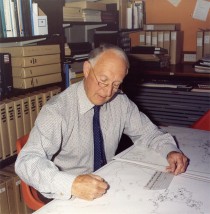By Verity Jones
In David Archibald’s post over at WUWT Premonitions of the Fall (in temperature) there was a comment from Dr Tim Ball that seemed worth giving a bit of separate life.

Hubert Lamb, Climatic Research Unit, University of East Anglia (Image source: http://www.aip.org click for link)
The full comment is here but I’ve excerpted most of it:
The IPCC has frozen climate science progress since its inception. Lamb knew what was going to happen as he recorded in his autobiography (1997). He created the Climatic Research Unit (CRU) because
“...it was clear that the first and greatest need was to establish the facts of the past record of the natural climate in times before any side effects of human activities could well be important.”
Lamb foresaw the potential architect for this diversion in the person of Tom Wigley who took over as director of the CRU. In my discussions with Lamb he said he felt his lack of computer skills was limiting. He hired Wigley to fill that gap at the CRU. He learned quickly it was a mistake. Here are his comments from the autobiography.
“The research project which I put forward to the Rockefeller Foundation was awarded a handsome grant, but it sadly came to grief over an understandable difference of scientific judgment between me and the scientists, Dr Tom Wigley, whom we appointed to take charge of the research.”
“The scheme had been to extract the information given in the wealth of descriptive reports of the nature of individual past seasons...”
“My plan was that these reports should be entered on maps of the reported weather character that prevailed in the individual seasons...”
The loss of this project underscores the problems Lamb anticipated because it is from such studies, Lamb recreated without the Rockefeller money, which is the basis for the material in Archibalds comments and Libby and Pandalfi’s predictions.
Lamb identified the problem with Wigley’s appointment and ultimately with the IPCC.
“My immediate successor, Professor Tom Wigley, was chiefly interested in the prospects of world climates being changed as result of human activities, primarily through the burning up of wood, coal, oil and gas reserves...”
“After only a few years almost all the work on historical reconstruction of past climate and weather situations, which first made the Unit well known, was abandoned.”

Wigley was instrumental in the application of computer models but as Lamb knew they were only to be as good as the data on which they were built. They were and continue to be a disaster, while Lamb’s work and the studies it engendered proves prescient.
The predictions Libby and Pandolfi made are based on Lamb’s work with midlatitude cyclonic and wind patterns. Wind remains one of the essentially overlooked components in climate studies. Hans Jelbring recognized this, but like any who knew and dared question what the IPCC were doing were subjected to attacks typical of politics rather than the open discourse essential to science.
As a result of this comment, I found myself reading parts of Lamb’s book: Lamb, Hubert H. (1977). Climatic History and the Future. Princeton, NJ: Princeton University Press (at least what I could read in the extended preview). Chapter 19 Manmade Climatic Changes is worth a look. It flows beautifully and is hiughly readable - the mark of a good communicator. It is also refreshingly devoid of bias - in fact it feels almost strange to read such a text, clearly written by a consummate scientist, but completely even-handed in his reporting. We might imagine he regularly rotates in his grave at the current state of writing in climate “science”.
I note his plan was to enter historical data on maps and I rather think that maps presenting Anthony’s Surface Stations Data and/or all the historic reports gathered by TonyB might be rather more true to Lamb’s original intentions than the adjusted, highly homogenised data currently presented to serve the political purpose that so disappointed Lamb.




